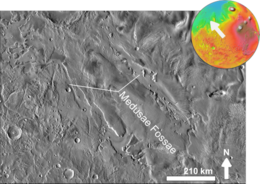Medusae Fossae Formation

Medusae Fossae based on THEMIS day-time image
|
|
| Coordinates | 3°12′S 163°00′W / 3.2°S 163.0°WCoordinates: 3°12′S 163°00′W / 3.2°S 163.0°W |
|---|---|
| Length | 333.0 km |
The Medusae Fossae Formation is a large geological unit of uncertain origin on the planet Mars. It is named for the Medusa of Greek mythology. "Fossae" is Latin for "trenches". Located roughly at 5°S 213°E / 5°S 213°E, it straddles the highland - lowland boundary near the Tharsis and Elysium volcanic areas. The Medusae Fossae Formation lies partly in five quadrangles: the Amazonis quadrangle, the Tharsis quadrangle, the Memnonia quadrangle, the Elysium quadrangle, and the Aeolis quadrangle.
The Medusae Fossae Formation is a soft, easily eroded deposit that extends for nearly 1,000 km along the equator of Mars. Sometimes, the formation appears as a smooth and gently undulating surface, however in places it is wind-sculpted into ridges and grooves. Radar imaging has suggested that the region may contain either extremely porous rock (for example volcanic ash) or deep layers of glacier-like ice deposits amounting to about the same quantity as is stored in Mars' south polar cap. Using a global climate model, a group of researchers headed by Laura Kerber found that the Medusae Fossae Formation could have been formed from ash from the volcanoes Apollinaris Mons, Arsia Mons, and possibly Pavonis Mons. Further evidence for a fine-grained composition is the fact that the area gives almost no radar return. For this reason it has been called a "stealth" region. The formation is divided into three subunits (members) that are all considered to be of Amazonian age, the youngest era in martian geological history.
...
Wikipedia
